

Following graduation as electrical engineers from Stanford University in 1934, Dave Packard and Bill Hewlett went on a two-week camping and fishing trip in the Colorado mountains. They discovered strong similarities in their attitudes toward most things and became close friends. Bill continued graduate studies at Stanford and MIT while Dave took a job with General Electric. With the encouragement of Stanford professor and mentor Fred Terman, the two decided to start a business "and make a run for it ourselves."
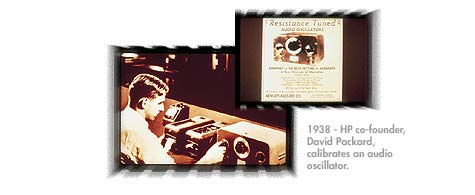
Dave and Lucile Packard move into house at 367 Addison Avenue, Palo Alto, California. Bill Hewlett rents cottage behind the house and Bill and Dave begin part time work in the garage with $538 in working capital.
|
|
This one-car garage behind 367 Addison Avenue in Palo Alto doubled as a workshop for Bill Hewlett and Dave Packard when they started business together. First tools were simple: a bench, vise, drill press, screwdriver, file, soldering iron, hacksaw and some purchased components. By 1940 the partners had outgrown the garage and rented part of a small building on Page Mill road, hiring their first employees to help with the production of instruments. In 1987 the garage was officially designated as a California State Historical Landmark and recognized both as HP's birthplace and a Silicon Valley milestone. |
Bill Hewlett's study of negative feedback results in HP's first product ... the resistance-capacity audio oscillator (HP200A), an electronic instrument used to test sound equipment. The oscillator used an incandescent bulb as part of its wiring scheme to provide variable resistance, a breakthrough in oscillator design. The principle of feedback provides the foundation for other early HP products such as a harmonic wave analyzer and several distortion analyzers.
This instrument offers breakthroughs in technology in size, price and performance. Walt Disney orders eight HP 200B oscillators for the production of Fantasia, and Hewlett-Packard Company is born.
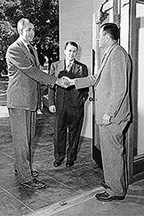
Partnership formed January 1, 1939; coin toss decides company name.
In 1939 William R. Hewlett applied for a patent with the United States Patent Office for his variable frequency oscillation generator, a resistance-capacitance tuned frequency audio oscillator. This instrument achieved a reputation as one of the most outstanding products in the history of the electronics instrumentation industry and remained on the market in a succession of models until 1985. It became a dependable workhorse in a wide range of research and development activities in industrial, military and university laboratories around the world. Prior to this invention, there was no simple and precise way of producing variable and stable signals in the low frequency range needed for measurements in acoustics, medicine, oil exploration, seismology, oceanography, structural vibration analysis, and many other fields whose natural processes involve these low frequencies.
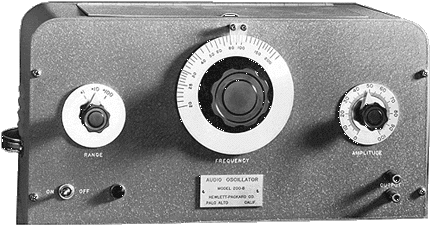
Hewlett's variable frequency audio oscillator used three feedback paths:

Products from the fledgling partnership won excellent acceptance among engineers and scientists. Bill and Dave signed with sales rep firms to market their increasingly popular products across the U.S. The start of World War II turned a trickle of U.S. government orders for electronic instruments into a stream and then a flood. New products were added and HP built the first of its own buildings.
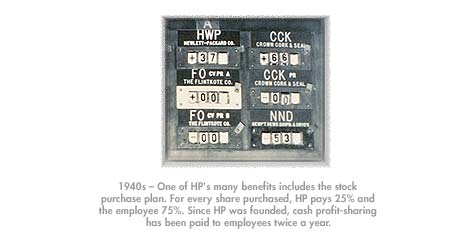
STOCK-PURCHASE PLANS become part of HP's employee benefits, making HP the first company to develop and implement cash profit-sharing.
DAVID PACKARD CREATES the concept of Management by Walking Around (MBWA). "I learned that quality requires minute attention to every detail, that everyone in an organization wants to do a good job, that written instructions are seldom adequate, and that personal involvement needs to be frequent, friendly, unfocused, and unscheduled—but far from pointless. And since its principal aim is to seek out people's thoughts and opinions, it requires good listening."
HP ESTABLISHES the Open Door Policy for all employees to ensure that employees at every level feel that managers are available, open and receptive, building the mutual trust and understanding that characterizes management style. Open cubicles and executive offices without doors make the policy integral to the HP working environment.

Hewlett-Packard went through a growing and maturing process in the '50s, learning much about the "new" technology of electronics and about the internal effects of growth. "How" the company grew was as hotly debated as "how much" the company should grow. This was the time when HP hammered out its corporate objectives -- the basis of its special management philosophy - and embarked upon a path toward globalization.
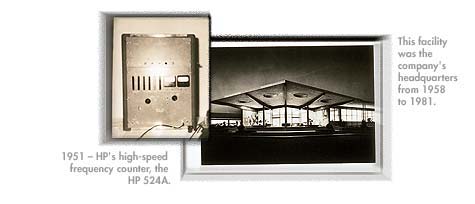
DIVISION STRUCTURE with separate profit-and-loss accountability is established. Each product group becomes a self-sustaining organization responsible for developing, manufacturing and marketing its own products. And to remain nimble, any group that grows to 1,500 people is divided and moved to a new P&L. The autonomy fosters individual motivation, initiative and creativity, and gives employees the opportunity to work with a wide latitude of freedom in achieving common goals and objectives. Dave Packard delivers a set of corporate objectives as a way to guide management decision-making
HP BECOMES GLOBAL and opens a large manufacturing facility in Boeblingen, Germany. Today, HP has offices in more than 120 countries.

HP continues its steady growth in the test-and-measurement marketplace, and branches out into related fields like medical electronics and analytical instrumentation. The company begins to be noticed as a progressive, well-managed company ... and a great place to work.
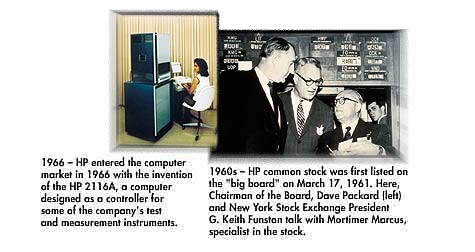

HP continued its tradition of innovation with the introduction of the first scientific hand-held calculator. And toward the end of the decade marked by significant growth in earnings and employment, Bill Hewlett and Dave Packard delegated day-to-day operating management of the company to John Young.
HP pioneers the era of personal computing with the first scientific hand-held calculator, the HP-35, which makes the engineer's slide rule obsolete.
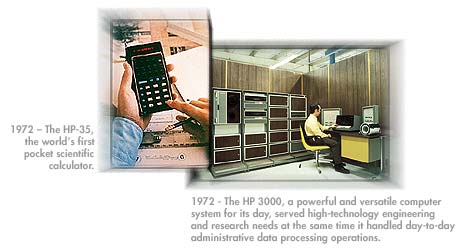
Branches into business computing with the HP 3000 minicomputer.

HP became a major player in the computer industry in the '80s with the a full range of computers from desktop machines to powerful minicomputers. And the decade marked the start of HP's successful march into the printer market with the launch of inkjet and laser printers that attach to personal computers.Early 1980s
PETER DRUCKER COINS the phrase Management by Objective (MBO) to describe HP's practice of stating clear overall objectives and allowing people the flexibility to work toward them in ways they determine are best. MBO is implemented as a structured methodology to develop integrated plans with specific expected results. HP's Japan offices win the Deming Application Prize for best planning practices.
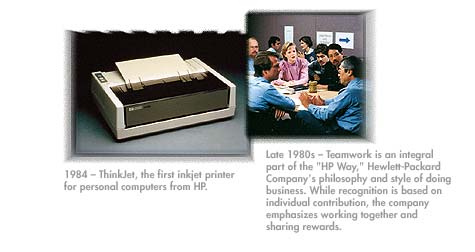

HP is one of the few companies in the world to successfully marry the technologies of measurement, computing and communication.
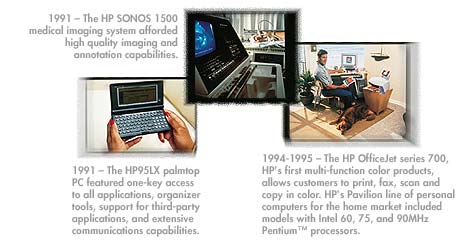
Introduces three-pound HP OmniBook 300 "superportable" personal computer with enough battery power to last during a flight across the United States.
Ships 10 millionth HP LaserJet printer; HP has now sold more than 20 million printers.
Dave Packard retires as chairman of the board of directors. Lew Platt named chairman, president and chief executive officer.
Revenues reach $25 billion.
HP produces the world's brightest LED (light-emitting diode). Combining bright output, reliability and low power consumption, they replace incandescent lamps in many new applications.
Introduces HP Color LaserJet printer.
HP PIONEERS HOME-OFFICE COMPUTING and expands its printer business. With the HP OfficeJet 710 all-color printer/fax/copier/scanner, customers get essential office functions in one easy-to-use product.
Introduces HP 200LX palmtop PC with built-in Pocket Quicken.
HP AND INTEL COLLABORATE in a historic move to develop a common 64-bit microprocessor
architecture, which promises to define computing in the 21st century.
Telecommunicating policies are formalized, making HP one of the first companies to encourage telecommuting around the world. Employees can work at home or remote HP offices. The result is rising job satisfaction, reduced commute time, increased flexibility to coordinate personal and work schedules, and lower levels of stress. HP benefits from reduced office-space requirements and improved employee retention. HP's intranet—the world's largest—links its global operations and ensures communication with employees wherever they are.
Net revenue: $31.5 billion; Employees: 105,200.
Acquires Convex Computer Corporation, Richardson, Texas-based supplier of high-performance computing solutions.
Introduces HP OmniGo 100 handheld organizer.
The HP Pavilion PC marks HP's highly successful introduction into the burgeoning home-computing market.
Co-founder David Packard dies on March 26.
Introduces the first multiple original printing "mopier," the HP LaserJet 5SI printer.
Revenue: $42.9 billion; Employees: 121,900.
Acquires VeriFone, the industry leader in electronic-payment systems, strengthening HP's capabilities in electronic commerce.
Launches new multi-year consumer-marketing program with the theme, "Expanding Possibilities."
Jetsend permits wireless interaction between computer peripherals and is incorporated into LaserJet printers and scanners. JetSend, developed by HP, quickly becomes an industry standard.
Revenue: $47.1 billion; Employees: 124,600.
HP Pavilion PCs reach No. 2 position in U.S. market.
Introduces HP CapShare 910, which lets mobile users electronically capture, store and share paper documents.
HP INTRODUCES TERAMAC, a computer architecture that automatically reroutes around defective chips to perform calculations. Using nanotechnology, chemicals create circuits, instead of silicon. The hope: Computers cost less yet are a billion times more powerful.
HP Names Carly Fiorina President and CEO.
HP Unveils Agilent Technologies at Historic Launch Event

E-SERVICES is HP's Internet strategy. It stems from HP's belief that the Internet will evolve from a collection of Web sites accessed via PC to a virtual marketplace of Internet-based services that can be invoked, on the fly, from any device. HP aims to address this evolution of the Net by fueling the creation of this new generation of e-services, by inventing a new breed of devices valued for their "just works" factor, and building the next-generation IT infrastructure required to flawlessly support a world where billions of devices are generating trillions of transactions.
E-SPEAK is an Internet software technology platform developed in HP Labs designed to revolutionize the way people and businesses use the Net. Much like HTTP and HTML made it easy for people to find and access information anywhere on the World Wide Web, e-speak is a service-based interaction model that makes it possible to create, request and locate services on the Net from any device.
DIGITAL imaging will let customers be more inventive as they capture and create, and share and print images. People's online experience of creating, viewing, posting, managing and e-mailing photos to friends, family and business associates will become as easy as "point and shoot."
May 2002, Hewlett-Packard merges with Compaq Computer
This merger creates an $87 billion global technology leader, with the industry's most complete set of IT products and services for both businesses and consumers. New HP has operations in more than 160 countries and over 145,000 employees.
New HP becomes the #1 global player in servers, imaging & printing, and access devices (PCs & handhelds), as well as Top 3 player in IT services, storage and management software.
The combination furthers each company's commitment to open, market-unifying systems and architectures and aggressive direct and channel distribution models.(2)
Last Updated on 7 October, 2002 For suggestions please mail the editors
Footnotes & References
1 This company history is adapted from HP'site and supplemented with the project's data 2 History of Computing CD, Digidome